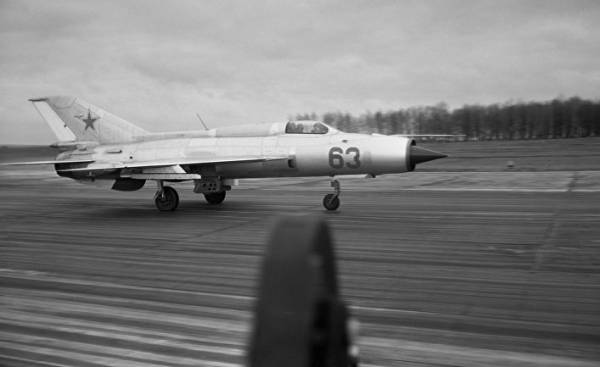
It is well known that the service life of military aircraft is extremely short, especially in periods of technological revolutions. The best aircraft of the First world war was obsolete within a few months. During the Second world war the situation was similar. At the dawn of jet aviation entire aircraft parks were written off as obsolete with the improvement of engineering and technology. The newest aircraft fought in the skies over Korea, just a few years turned into junk.
But some samples were able to withstand the test of time. Strategic bomber B-52 Stratofortress made its first flight in 1952, but is still in service. New C-130 aircraft to continue off the production lines, although they are based on the design of the machine, which entered service in 1954.
But all the bombers and transport planes, which do not need to fight each other. In the case of fighters, the problem of fragility is particularly acute, because they had to directly confront the latest models. So the fighter has a very short life, both in production and in service.
The exception to this rule was the MiG-21.
The history of creation
Initial inspection on the serviceability of the MiG-21 took place in 1953. The success of the MiG-15 and MiG-17 testified that the Soviet aircraft designers can compete with their Western counterparts, the MiG-19 became the first Soviet supersonic fighter. However, in the first two decades of the jet technology was changing so fast that the fighters that were used in the Korean war, to the middle 1950-x years outdated. The MiG-15 could split the combat b-29, but for modern American bombers they couldn’t keep up. The Soviet leadership believed that the creation of the MiG-21 will change and the aircraft will help provide air superiority.
The MiG-21 (Fishbed by NATO classification) was able to develop a supersonic speed of M=2. It was equipped with a built-in cannon and could carry on Board from two to six missiles (the aircraft appeared before the missiles). Like most fighters, it eventually became used as attack aircraft, and in this role it could carry on Board a limited number of bombs and unguided rockets. As in the case with many other fighters, the Soviet military preferred to control the MiG-21 aircraft from the ground, which allowed them to abandon the cumbersome and complicated radar equipment.
Only in the USSR in the period from 1959 to 1985 was created 10 645 MiG-21. Under the agreement with Moscow on licensing and technology transfer India built 657 such fighters, and Czechoslovakia — 194 for the license. Under strange and questionable circumstances, people’s Republic of China acquired a sufficient number of aircraft and the technical documentation on them, then to copy the MiG-21 and turn it into a J-7/F-7. In 1966-2013 years China has produced about 2,400 fighters. Together, the MiG-21 became the most numerous supersonic fighter in history.
Lifetime
The creators of the MiG-21 has decided a series of important issues, then the developers failed to significantly move forward. The fighters speed is not much higher than that of the MiG-21 maneuverability is irrelevant they are superior to the old Soviet model. Modern cars carry on Board more ammunition and equipped with more modern electronic equipment, however, the armed forces of many countries see this as an unnecessary luxury, since they need cheap, fast, and easy to maintain aircraft that can patrol the airspace and from time to time to drop a couple of bombs. And the MiG-21 is ideal for this purpose.
It is worth noting that the MiG-21 would not bring much use of fighter aircraft in the West. He has small range, few weapons, and there is no room to install sophisticated electronic equipment. The shape of the cabin limits the awareness of the pilot about the environment. However, the MiG-21 fully satisfy the needs of the USSR in the fighter, which was able to fly and fight on the battlefield in Western Europe and to some extent to perform the functions of the interceptor.
During the cold war, the United States has received several modifications to the MiG-21 (they eventually bought a squadron of Chinese fighters J-7). In General, American pilots spoke highly of the MiG-21, because he looked very good in the learning process with the participation of the imaginary enemy.
The MiG-21 at war
The MiG-21 do not have to fight on the Central front in the war between NATO and Warsaw Pact countries, but he has repeatedly participated in the fighting.
In Vietnam, it became clear that compact and quick MiG-21 due to its size and speed, ability to cut the combat formation of bombers before American fighters will be able to notice them and subjected to impact. The size and maneuverability of the MiG-21 also allowed him to promptly escape from the rockets of class “air-air”. After the attack of the MiG-21 quickly returned home.
The exception to this rule was the incident that occurred on 2 January 1967, when a group of F-4 Phantom II under the command of the legendary Robin Alza pilot (Robin Olds) outsmarted the Vietnamese command, luring pilots into a deadly trap. That day Phantoms shot down seven MiG-21, including the car, Nguyen van Coca (Nguyen Van Coc), which survived and subsequently to the end of the war, he shot down nine enemy aircraft. Nguyen became the most successful pilot of the MiG-21 in history, although several other Vietnamese and Syrian pilots also were awarded the title of ACE, flying this fighter.
The MiG-21 has often been used in wars in the middle East. Bombers of the Israel defense forces dealt a crushing blow to the Egyptian and Syrian MiG-21 during the first battles of the six day war. The MiG-21 fought with Israeli fighters in the War of attrition in the Arab-Israeli war and the Lebanon war, suffering heavy losses from outstanding Israeli pilots. One Israeli fighters ambushed and destroyed a number of MiG-21, managed by Soviet pilots.
The success of Western aircraft in opposition to the MiG-21 in the middle East, and Angola has led many to conclude that the Soviet fighters are inferior to Western counterparts. However, to carry out such comparisons is difficult due to the difference in the level of training of pilots. When level of training was about the same, the MiG-21 was acting very dignified. For example, the Indian MiG-21 took part in the Indo-Pakistani war of 1965, showed good results in the war of 1971 and the Kargil conflict. They have also demonstrated its effectiveness in the war between Iran and Iraq.
Modernization
Number operated the MiG-21 was reduced in the late 1980s and early 1990s, when they were replaced they began to come to more modern models, and when the collapse of the Soviet Union led to a sharp decline in military power of Russia. The satellites of the Soviet Union also felt the effects of that disintegration and could no longer afford to keep these aircraft in service. But many countries still use the MiG-21 and its Chinese counterparts.
The MiG-21 is currently in service in 18 armies of the world, including two members of NATO (Romania and Croatia). Since 1960, the MiG-21 was in service with armies around 40 countries (count them accurately is quite difficult, because some countries have ceased to exist, and their MiGs continued to fly). Chinese fighter J/F-7 remain in service in 13 countries. China, Russia and Ukraine still carries out maintenance and modernization of existing aircraft. With the invention of 3D printing today to the owners of MiG-21 will be easier to serve them because they will be able to produce the necessary spare parts and to carry out modernization work.
Currently fielded MiG-21 are very different from the fighter, which was built in 1959. They feature a brand in other, more complex weapons systems, including missiles R-60 class “air-air”, Magic 2 and Python III. This makes them much more deadly than Soviet predecessors. In addition, they are equipped with more sophisticated electronic equipment and communication systems that allow them to deliver to target precision-guided munitions.
Will the MiG-21 in service until 2059?
China ceased production of J-7, and it means that with the Assembly line went down last variant of the MiG-21. Croatia and Romania will be removed from the armament of the MIG-21 for a period of five years. After several crashes, India will also abandon their MiG-21 (in that case, if she will be able to buy or create a replacement). The Chinese J-7 is now used mostly for training purposes.
However, all this does not mean that the MiG-21 came to an end. Many modifications of the J-7 and F-7 are quite modern and can remain in service for a long time. Bangladesh acquired the latest batch of J-7 in 2013 and soon his replacement will not be required. The armed forces of many countries simply do not need more complex and expensive aircraft than the MiG-21. Most likely, no single model of a fighter fails to live up to 100 years (although the b-52 there are certain chances it’s up to decommissioning). But the MiG-21 can easily note sixties and even seventies anniversary since its creation. It remains one of the most legendary fighter of the supersonic era.
Robert Farley is a frequent contributor to the publication The National Interest. He is the author of The Battleship Book. Petersenovskaya Farley teaches at the school of diplomacy and international trade (Patterson School of Diplomacy and International Commerce) at the University of Kentucky. His work includes military doctrine, national security, and Maritime Affairs.






